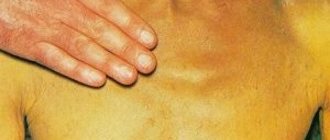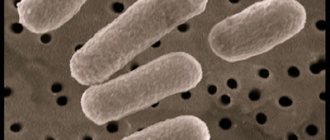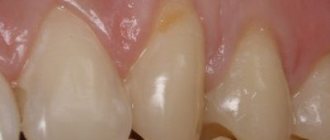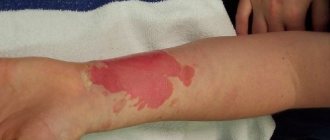Causes of pain in the tonsils
Mechanical damage
One of the most common causes is mechanical damage. This may include food damage, for example, a hard piece of bread or a fish bone, which can easily scratch the tonsil. A doctor examining your throat may accidentally injure it. There are many options, it is impossible to list them all. The tonsils become inflamed in the same way as a scratch on the arm or any other area of the skin.
Angina
One of the most common problems that absolutely any person has encountered. This is an infectious disease that is accompanied by inflammatory processes, in more complex cases - purulent. The main symptoms are:
- High body temperature, which reaches 40 degrees (how to bring it down).
- Constant malaise and weakness.
- Severe sore throat that gets worse when swallowing.
Treating tonsils with pus is not particularly difficult, the main thing is not to delay and start treatment as quickly as possible.
How to identify a sore throat
Complications
A problem that occurs less frequently than others, but is also one of the main causes. Prolonged delay in treatment of diseases of the throat, nose and ears can lead to serious complications in the tonsils. Purulent sore throat, tonsillitis plugs, laryngitis, pharyngitis - this is the least that can appear after complications. Therefore, do not delay treatment.
Inflammation of the larynx as a result of complications
Pharyngitis
An unpleasant disease of the throat, which affects the mucous membrane and lymphoid tissue due to inflammatory processes. Main symptoms:
- acute sore throat;
- constant itching;
- dry cough, which feels like it is tearing at the larynx.
All of the above reasons are quite unpleasant, but it is quite simple to deal with them; the main thing is to start treatment as soon as the first symptoms appear. This will allow you to get rid of the disease in the shortest possible time with minimal discomfort.
An additional way to cleanse the tonsils is the lion pose. Repeat 3-5 times in a row, 3 times a day
Signs and symptoms of chronic tonsillitis
Chronic tonsillitis occurs in 2 forms - simple and toxic-allergic of 2 degrees. Angina with the disease recurs up to 3 times a year. Less often - up to 6 times a year. The presence of pus in the lacunae of the tonsils is a reliable sign of tonsillitis, even if it is asymptomatic. Asymptomatic sore throat occurs in 4% of cases.
Concomitant diseases and tonsillitis aggravate each other. In patients suffering from hyperthyroidism, diabetes mellitus, tuberculosis, diseases of the gastrointestinal tract, etc., tonsillitis is severe and has complications.
Signs of chronic tonsillitis
The following signs indicate chronic tonsillitis:
- Fusion of the anterior and posterior arches with the tonsil.
- Swelling of the area of the upper angle formed by the arches (Zach's sign).
- Hyperplasia of the upper edges of the arches (B. S. Preobrazhensky sign).
- Hyperemia of the anterior arches (Gise's sign).
- The size of the tonsils depends on the constitutional characteristics of the person, is a variant of the development of the organ, or is a manifestation of an allergic condition. Enlarged (hyperplastic) tonsils promote and maintain the inflammatory process. The surface of the tonsils can be loose or smooth.
- In chronic tonsillitis, the accumulated pus in the lacunae can be liquid or thick. Upon examination, the presence of purulent plugs in the lacunae is noted. Pus in the lacunae causes an unpleasant putrid odor from the mouth, which is an important sign of chronic tonsillitis.
- Enlargement of the cervical and submandibular lymph nodes is an important sign of chronic tonsillitis. This sign becomes especially important in the absence of inflammation in other parts of the head area. Each of the above symptoms may have varying degrees of severity. The disease often occurs against the background of chronic pharyngitis.
The presence of pus in the lacunae and the recurrence of sore throats throughout the year, occurring with symptoms of toxicosis, are reliable signs of chronic tonsillitis, which in themselves are highly reliable.
Rice. 3. The photo shows chronic tonsillitis. The main signs of the disease are evident; pus and purulent plugs are visible in the lacunae.
Symptoms of chronic tonsillitis
Symptoms of chronic tonsillitis. Simple form
Each of the above symptoms can have varying degrees of severity and are often recorded in chronic tonsillitis. The function of other organs is not impaired. There are no symptoms of intoxication. Treatment is conservative. If pus in the lacunae persists as a result of several courses of treatment, then tonsillectomy is indicated.
Rice. 4. The photo shows chronic tonsillitis. Pus and purulent plugs in the lacunae are visible. The tonsil on the right is enlarged.
Symptoms of chronic tonsillitis. Toxic-allergic form
The infectious-allergic background, which is created as a result of frequent exacerbations of chronic tonsillitis, is the trigger for the development of associated diseases: paratonsillitis, parapharyngitis and rheumatism. The human body responds to the introduction of streptococci by producing antibodies, thanks to which they are destroyed. But often antibodies begin to attack structures similar to streptococcus, which are the connective tissue of the heart and joints, as a result of which heart defects and arthritis develop. In addition, streptococcal enzymes themselves have a cardiotoxic effect.
Toxic-allergic form I is characterized by low-grade body temperature, increased fatigue, weakness, pain in the heart and joints, and tachycardia. Symptoms of the disease during periods of exacerbation are pronounced. Outside of exacerbations, all symptoms are absent. ECG changes are transient. Local associated diseases manifest themselves in the form of paratonsillitis and parapharyngitis.
In toxic-allergic form II, symptoms such as low-grade body temperature, pain in the heart and joints bother the patient even outside the period of exacerbation. Laboratory diagnostics confirm damage to the kidneys, liver, heart and vascular system. Local associated diseases manifest themselves in the form of paratonsillitis and parapharyngitis. Associated diseases of a general type manifest themselves in the form of rheumatism, nephritis, endocarditis and tonsillogenic sepsis - diseases that have a common infectious-allergic nature.
Rice. 5. The photo shows chronic tonsillitis. The tonsil on the left is significantly increased in size. Pus and purulent plugs in the lacunae are visible. The main signs of the disease are present.
How to wash tonsils
Inflamed tonsils can also be treated mechanically. It often happens that purulent plugs are so densely lodged in the tonsils that it is impossible to get rid of them without special means.
Flushing with a syringe
In this case, a special syringe for washing the tonsils comes to the rescue. It has a very long tube at the end, which allows you to wash the tonsils in the farthest corners. If it is not possible to purchase one, you can take a regular syringe without a needle, but then you will not be able to deeply rinse the tonsils.
Fill the syringe with warm, clean water, insert the tube into the tonsil and press all the way. The purulent plugs begin to come out immediately, you can massage the tonsils with your fingers, most importantly, do not forget to disinfect them. Continue rinsing until the plugs stop coming out. Do the above procedure with the second tonsil. After rinsing, treat your throat with an antiseptic.
The syringe can be purchased at the pharmacy
How to rinse with a cotton swab
This method is useless for internal washing of the tonsils, but it can remove plaque from above. Take a cotton swab and soak it in the antiseptic solution. Pass it over the tonsils with pressure. Do this until the plaque begins to come off and remain on the tampon. After the procedure is completed, treat your throat with an antiseptic.
Irrigator
This is a device for automatically supplying water with a thin stream. If you don’t have it, then there is no point in buying it, since it costs more than 3000 rubles. Used for oral hygiene.
The technique for rinsing the tonsils is the same as with a syringe, except that the water is supplied automatically. Direct the thin tube into the tonsil and turn on the irrigator. Adjust the water pressure from weak to strong. After rinsing, treat your throat.
Cleansing with an irrigator
Conservative treatment of chronic tonsillitis
Treatment of chronic tonsillitis can be conservative or surgical (removal of tonsils or tonsillectomy, removal of part of an organ). In the first stages of development of chronic tonsillitis, occurring in compensated or decompensated forms (during periods of exacerbation), as well as in cases of contraindications, drug treatment is indicated. If pus and purulent plugs continue to remain in the lacunae after several courses of treatment, or if serious complications develop, surgical treatment is indicated. When diagnosing a patient with toxic-allergic form II of chronic tonsillitis, urgent tonsillectomy is indicated.
Conservative treatment of chronic tonsillitis
Treatment of the compensated form of chronic tonsillitis is carried out during exacerbations of the disease, but at least 2 times a year.
- Antibacterial treatment is carried out during exacerbations of the disease in short courses.
- Irrigation (rinsing) of the throat is an important condition for healing. For this purpose, sprays and solutions with antiseptics are used. Solutions of Miramistin, Octenisept and Dioxidin are widely used.
- Treatment in the form of inhalations is prescribed with drugs such as Furacillin, Tonsilogon N, Dioxidin, etc.
- For the toxic-allergic form of the disease and severe swelling of the tonsils, antihistamines of the 2nd and 3rd generations are used.
- For severe pain, the treatment regimen includes such painkillers as Ibuprofen, Nurofen, Paracetamol, Naproxen, Adavil, Aspirin for adults.
- The use of physiotherapeutic procedures occupies one of the important places among the methods of conservative treatment of chronic tonsillitis. Among them, the leading place is occupied by ultraviolet irradiation, exposure to high-frequency electromagnetic fields UHF (microwave), methods of using ultrasonic aerosols, therapeutic mud and ozokerite.
- An important component of drug treatment is increasing immunity. Vitamin therapy, the use of biostimulants and immunocorrectors stimulate the restoration of the patient’s immune status.
Removing tonsil plugs
Washing tonsils and removing plugs
Rinsing the tonsils and removing plugs should be carried out by a doctor. Stage 1. By pressing on the area of the outer arch of the tonsil, pus can be released from lacunae and purulent plugs. When removed independently, the plugs can penetrate into deeper areas of the lacunae and subsequently cause aggravation.
Washing of the tonsils on an outpatient basis is carried out using a syringe. At its end there is a cannula tube. The purulent plug is washed out of the lacuna under the pressure of the antiseptic solution. In case of tortuosity of the lacunae, the procedure may be ineffective. Usually 5 treatment sessions are prescribed. The lack of effect after 2 - 3 courses of full treatment is an indication for tonsil removal.
Rice. 8. Rinsing lacunae with a syringe.
Semi-surgical treatment method
A semi-surgical method for the treatment of chronic tonsillitis or lacunotomy is used to dissect scar changes that lead to narrowing of the mouth of the lacunae. This technique is carried out using the Surgiton apparatus.
Rice. 9. The Surgiton device is widely used in various fields of medicine.
Removing traffic jams using hardware
In some cases, removal of plugs is carried out using the Tonzillor device. The essence of the method is to create a vacuum in the tonsil area and subsequent deep rinsing of the lacunae using ultrasound and phonophoresis. The device has a large number of applicators, allowing it to be used by both adults and children. Typically 10 treatment sessions are performed. If necessary, the procedure is repeated after six months. In some cases, when the patient is bothered by painful sensations, the procedure is carried out using anesthetics TheraFlu LAR, Strepsils Plus, etc.).
Rice. 10. Tonsillor device.
The method of removing pus and purulent plugs from lacunae and crypts of the tonsils manually (washing the lacunae) and using the hardware method is widespread in the treatment of this disease. The effect is achieved purely mechanically with subsequent restoration of the drainage function of the tonsils.
Rinse for inflammation of the tonsils
In case of inflammation of the tonsils, mandatory rinsing will be required.
Medicines
In the modern world there is a huge selection of means for irrigating the mouth and throat, the most effective of which are:
- Levomycetin . Allowed for use only from 6 years of age. Local antiseptic used for inflammation of the tonsils, which contain pus, and ulcerative stomatitis. To prepare the solution, you need to dilute a quarter of the tablet with one glass of warm water.
- Eludril . A solution containing chlorobutanol and chlorhexidine. Antifungal, anti-inflammatory and antibacterial agent, thanks to which inflammation occurs within 7 days.
- Stopangin . Consists of essential oils and hexetidine. Antibacterial agent with anti-inflammatory effect. Treats almost all diseases associated with inflammation of the throat.
Prevention of the disease
Of course, you can effectively treat tonsillitis and all its symptoms, but the most effective method is prevention, which includes a number of measures.
Among them the following can be noted.
- During the period of respiratory diseases, you should take “Anti-angin” - this is a good prevention of inflammation of the tonsils.
- Hardening: wiping with a damp towel, gargling with cool water.
- Moderate sports activity: morning jogging, physical education is an excellent prevention of all ailments.
- Walks in the open air.
- Eating plenty of vegetables and fruits.
So, the best treatment for tonsillitis is its prevention. Follow all the tips and stay healthy!
Inhalations
3 most effective inhalation recipes for coughs and problems with tonsils:
- Inhalation with potatoes. Boil the potatoes and leave them in the pan. Many doctors advise adding pine essential oil or sea salt to it. Do not breathe over it immediately, there is a risk of getting burned. Cover yourself with a warm blanket and slowly inhale the steam. Do this until the potatoes stop steaming.
- Herbal inhalations. They are made using a kettle; a long hose up to 50 cm long is put on the spout. Buy a mixture of herbs intended for inflamed tonsils; they have anti-inflammatory and analgesic effects. This could be chamomile, oak bark, eucalyptus, calendula, thyme, yarrow, etc. You can drip essential oil into the grass. Brew everything in a kettle and let it brew for 1 hour. Inhale carefully, do not overdo it, otherwise you risk drinking very hot water.
- Inhalations with a heating pad. Pour the crushed validol into a heating pad, pour boiling water over it and wait a couple of minutes so as not to get burned. Then begin to inhale from the bell. Instead of validol, you can use all the herbs that were described in the previous method.
After inhalation, be sure to lie down under a blanket!
Enlarged tonsils and tonsils in children
Children are much more susceptible to inflammation of the tonsils than adults. An important point: the tonsils are almost the only formed organ of the children's immune system, therefore their normal functioning is very important for the full development of a growing and developing organism. Therefore, you should be extremely careful about diseases of these glands in children. At the first sign of enlarged tonsils in a child, you should consult a doctor.
In newborns, tonsils are present only in their infancy (in the form of follicles). Their complete formation with the normal development of the baby ends at approximately six months of age. From this time on, serious inflammation is possible, although problems with developing tonsils may occur earlier. For young children, the prevention of tonsillitis is especially important - optimal room temperature, proper nutrition, complete exclusion of too cold, hot food and drink.
If a child has enlarged tonsils on one or both sides, it is advisable to immediately conduct an examination. The situation cannot be neglected, as this can contribute to the occurrence of chronic diseases.
In itself, enlargement of the palatine glands is not a symptom of the disease; it may also indicate normal functioning of the immune system. Therefore, instead of self-medication, you need to consult a doctor in a timely manner.
Warming up
The basic technique is heating the diseased areas with warm objects, which can be done at home. You can use a regular chicken egg, hard-boil it, and keep it near the sore spot until it cools completely. If it is very hot, you can wrap it in cloth. Also one of the most common options is to heat salt in a frying pan, pour it into a rag bag and tie it tightly. Apply to the tonsils until it cools completely. After the procedure is completed, be sure to wrap your throat with a warm scarf or something similar.
Causes
In healthy people, the entry of various infectious pathogens into the tonsils causes the cells to recognize foreign agents, destroy them and activate the immune system. But in cases where the lymphatic tissue for some reason does not have time to destroy the infection, an inflammatory process or tonsillitis develops in the palatine tonsils. In most cases, the cause of tonsillitis is a previous sore throat. Less commonly, the cause of the disease is chronic infectious diseases of other ENT organs, caries, sinusitis, etc.
Causes of chronic tonsillitis
During the examination, you can find that the tonsils contain microorganisms such as streptococci and staphylococci. Other causes of chronic tonsillitis: curvature of the nose, causing impaired nasal breathing, nasal polyps, decreased immunity.
Answers to frequently asked questions
Is it possible to cure tonsils in 1 day?
The unanimous answer of all doctors is no. You will not be able to completely heal inflamed tonsils in such a short period of time. If your throat is just starting to hurt, there is a chance to significantly reduce the pain and speed up recovery by 2-3 days. Follow the tips below:
- Gargling should be done as often as possible.
- Use antiseptics.
- As strange as it may sound, bed rest allows you to recover much faster. Doctors unanimously say that you can’t endure illnesses on your feet; complications may arise. Plenty of warm drinks and bed are the best helpers in the fight against sore throat.
- If the patient has a high temperature, do not bring it down immediately. Often the body “warms up” itself to kill the pathogen. If the patient's general condition is satisfactory, do not rush. Reduce the temperature only when it already rises to 39 degrees.
There is also one way that also allows you to quickly cope with the disease. This is a gargle with iodine (blue iodine): 2 tbsp. We dilute spoons of the drug in a glass of warm boiled water and gargle. After the procedure, do not drink or eat for 20 minutes. The course of treatment is 7 days. Should not be used by pregnant women or people with
When should you take antibiotics?
Remember that antibiotics are one of the strongest medicines; they can only be taken with the permission of a doctor and in a clear dosage. If you don’t have the strength to go to the hospital, then you can take them at home yourself, most importantly, be extremely careful and strictly follow the instructions and dosage.
If there are no contraindications, you can take antibiotics from day one to weaken the bacteria and prevent the risk of new ones. The only thing you must be sure of is the nature of the inflammation - it must be bacterial or fungal, otherwise taking antibiotics will only harm the body.
Complications of chronic tonsillitis
General complications
The peculiarity of streptococcal infection is to cause an autoimmune response, leading to serious complications of internal organs:
- rheumatic damage to the heart muscle;
- joint damage (arthritis);
- kidney damage (glomerulo- and pyelonephritis).
When microbes enter the bloodstream and massively multiply, sepsis and meningitis can occur.
Local complications
Local complications include:
- otitis;
- laryngitis;
- swelling of the larynx;
- peritonsillar abscess;
- mastoiditis;
- abscess and phlegmon of fiber.
Sore throat phlegmonous
Phlegmonous tonsillitis develops in patients with chronic tonsillitis. Initially, lacunar tonsillitis develops. Pus and purulent plugs form in the lacunae. Next, the inflammatory process moves to the lymphoid tissue of the tonsil and to the peri-almond tissue. The focus of inflammation in the peri-almond tissue displaces the tonsil in the opposite direction. Against the background of severe hyperemia, significant swelling of the soft palate is noted. A putrid odor appears from the mouth. Lymph nodes are enlarged and sharply painful.
Rice. 6. Combination of phlegmonous and fibrous tonsillitis. The focus of inflammation in the peri-almond tissue displaces the tonsil in the opposite direction. Against the background of severe hyperemia, significant swelling of the soft palate is noted. A whitish film is located on the surface of the tonsil and extends beyond it.
Paratonsillitis
Peritonsillitis is characterized by the appearance of inflammation in the peri-almond tissue. The disease is one of the local complications of tonsillitis. Swelling, the appearance of infiltrate or abscess are the main signs of the disease. The localization of paratonsillitis varies, but most often the inflammatory focus is localized in the area of the upper pole, where there is no capsule and the tonsil tissue is loose. Localization is one-way. Intense excruciating pain and symptoms of toxicosis are the main symptoms of paratonsillitis.
Peritonsillar abscess
With a complicated course of angina, an abscess (accumulation of pus) may form in the paratonsillar zone. Very quickly the mucous membrane over it becomes thinner and an opening occurs (usually the abscess is opened surgically). The patient's condition quickly returned to normal after the autopsy. Pain of a “tearing” nature, which intensifies when swallowing, increased salivation, strong odor from the mouth, toxicosis and lockjaw are the main symptoms of the disease.
Rice. 7. The photo shows a peritonsillar abscess. The spherical formation displaces the palatine arches and soft palate in the opposite direction.
Cellulitis, paratonsillitis and abscess are sequential stages in the development of purulent inflammation of the tissue of the tonsils











